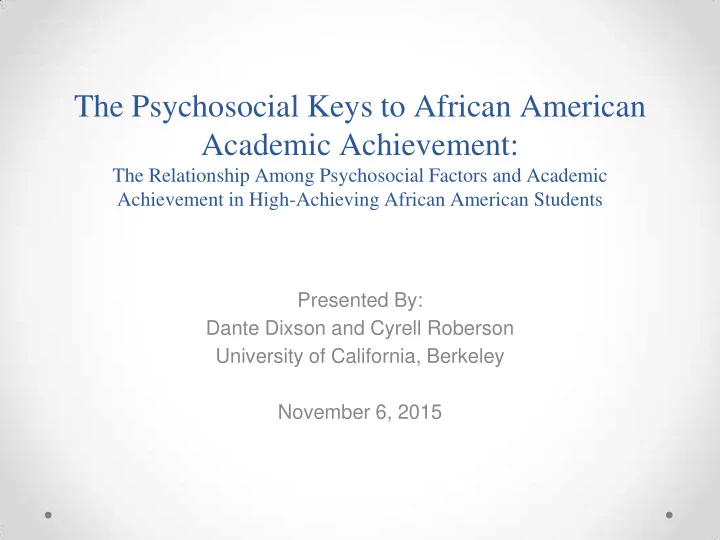

The Psychosocial Keys to African American Academic Achievement: The Relationship Among Psychosocial Factors and Academic Achievement in High-Achieving African American Students Presented By: Dante Dixson and Cyrell Roberson University of California, Berkeley November 6, 2015
Presentation Outline • The Achievement Gap • Objective of the Study • Psychosocial Factors o Time Frequency o Malleable Views of Intelligence o Grit o Ethnic Identity • Method • Results • Discussion • Conclusion • Q & A
The Academic Achievement Gap
Objective • Purpose: To examine the relationship between five psychosocial variables and academic achievement in a high-achieving, African American sample • Goal: To develop research-based interventions for lower achieving African American students based on our findings
Research Questions 1. Are there positive correlations among grit, ethnic identity, time orientation, malleable views of intelligence, and academic achievement? 2. Which variables attribute the most variance to academic achievement? 3. What percentage of the variance in academic achievement does each variable account for in the sample?
Psychosocial Factors • Time Perspective • Malleable Views of Intelligence • Grit • Ethnic Identity and Other Group Orientation
Time Frequency • Definition: How often one thinks about the past, present, and future . o Future Orientation ➔ academic achievement of high school, college, and graduate students
Malleable Views of Intelligence • Definition: Dweck (2002) has identified two sets of beliefs that people have about intelligence. o Fixed mindset: the belief that intelligence is a static trait. Individuals with this mindset believe either you are born smart or you are not. o Growth mind-set: individuals with a growth mindset believe intelligence can be developed in various ways, such as effort and instruction • Growth mind-set ➔ raises students’ grades and achievement test scores
Grit • Definition : one’s perseverance and passion for accomplishing long-term goals • Grit ➔ perseverance in school, the military, the workplace, and marriage (EskreisWinkler, Shulman, Beal, & Duckworth, 2014)
Ethnic Identity • Definition : an individual’s “knowledge of his membership [in] a social group” as well as “the value and emotional significance attached to that membership”. • Ethnic identity ➔ positive learning, developmental, and psychological outcomes; meaningful, yet negative predictor of GPA in academically talented African American students • Other Group Orientation (OGO): the general responses that members of one ethnic group have towards groups other than their own • OGO ➔ self-esteem in African American students
Method • Participants: o 176 African American 10th and 12th graders • Ages 15-18 (16) • Grades 3.0 and above (3.17) • Measures: o Time Perspective Scale o Implicit Theories of Intelligence Scale (ITIS) o Grit Scale o Multigroup Ethnic Identity Measure (MEIM) o Self-reported GPAs • Procedure: o Survey administered to Bay Area high school students
Results The profile of high achieving African Americans • They moderately embrace identifying themselves as gritty. • They generally believe that their mindset is malleable. • They think about the different time orientations fairly often. • They are neutral about embracing their ethnic identity. • They are neutral about embracing other ethnic groups.
Results (Cont.) How much are Grit, MIndset, Time Frequency, Ethnic Identity, and Other Group Orientation related to one another? Other Time Ethnic Grit Mindset Group Frequency Identity Orientation Grit 1 Mindset .20* 1 Time .06 .07 1 Frequency Ethnic .17 .02 .08 1 Identity Other Group .13 .24* .18 .67** 1 • r = .3 / R ² = .1 Orientation
Results (Cont.) How much do these variables contribute individually to GPA in the high achieving African American sample? • How to the variables compare to each other? • Is the pattern different for high achieving African Americans?
Results (Cont.) How much do these models contribute? • Sex and age • Grit, Mindset, Time Frequency, Ethnic Identity, Other Group Orientation
Discussion • Variables were related to one another, but small effect size • Grit and mindset where biggest predictors of GPA o All predictors were much smaller for this population than is reported in other populations • Whole model only explained a very small portion of GPA’s variance. o Maybe look elsewhere (e.g., perceived SES and academic self-efficacy)
Conclusion • Still a mythical population o Not same relationships, not same interventions o Gap remains, little research on high achieving African Americans • May not be one thing o No silver bullet • Future research o Should take into account the differences that are commonly associated with different ethnic groups • SES, culture, and other environmental factors
Questions?
Acknowledgments • Berkeley Unified School District • Dr. Frank Worrell • This study was funded by the African American Success Foundation, Inc.
Recommend
More recommend